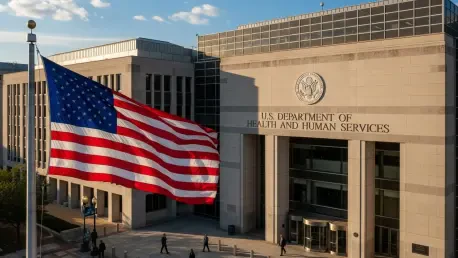I’m thrilled to sit down with Donald Gainsborough, a political savant and leader in policy and legislation, who is at the helm of Government Curated. With his deep expertise in federal labor relations and government policy, Donald offers unparalleled insight into the recent moves by the Health and Human Services Department (HHS) to terminate union contracts under President Trump’s executive order. In this conversation, we’ll explore the implications of this policy shift, the legal battles surrounding it, the impact on federal workers, and the broader context of national security and public health priorities.
How would you describe the core purpose of President Trump’s Executive Order 14251, and what does it mean for federal workers’ collective bargaining rights?
I’m glad to break this down. Executive Order 14251, issued in March, is fundamentally about reshaping the relationship between the federal government and its workforce by significantly limiting collective bargaining rights for a large portion of federal employees—about two-thirds of them, to be precise. It leverages a lesser-known provision of the 1978 Civil Service Reform Act to argue that such restrictions are necessary for national security. The order essentially seeks to streamline agency operations by reducing union influence, though it does carve out exemptions for certain groups like police officers and Customs and Border Protection personnel, recognizing their unique roles.
Can you walk us through the specific changes happening at HHS with the termination of union contracts, and who’s being affected by this?
Absolutely. HHS recently moved to terminate union contracts across several of its subcomponents, including high-profile offices like the Food and Drug Administration, the Centers for Disease Control and Prevention, and the National Institutes of Health, among others. This impacts unions such as the American Federation of Government Employees and the National Treasury Employees Union, which have been “de-recognized” in these spaces. We’re talking about a significant number of workers—potentially thousands—who are now operating without the formal protections and representation these unions provided.
HHS claims that removing union activities will help prioritize health and security. How do you evaluate this argument based on your experience with federal policy?
It’s a contentious claim, to say the least. HHS argues that by eliminating union-related obstacles, they can better focus resources and personnel on critical public health missions and national security priorities. They suggest that union activities can slow down responses to urgent threats or divert attention from taxpayer needs. While efficiency is always a goal in government operations, I’m skeptical that unions are the primary barrier to rapid response. Historically, unions have often worked collaboratively with agencies during crises, and there’s little concrete evidence showing they’ve significantly hindered HHS’s mission-critical work.
Beyond HHS, other federal agencies have also started canceling union contracts. Can you shed light on how widespread this trend is becoming?
This is indeed a broader movement. The Veterans Affairs Department was the first to act, terminating its collective bargaining agreements earlier this month. Following suit, we’ve seen similar actions from the Federal Emergency Management Agency, U.S. Citizenship and Immigration Services, and parts of the Agriculture Department, like the Food Safety and Inspection Service. The timing of these cancellations is notable because they’ve often moved ahead despite initial guidance from the Office of Personnel Management to hold off until legal challenges are resolved, which shows a determined push across multiple agencies to implement this policy swiftly.
There’s a lot of legal back-and-forth about this executive order. How are the ongoing court battles influencing what’s happening on the ground at agencies like HHS?
The legal landscape here is quite dynamic. Unions have challenged the executive order, and while a couple of appellate courts have issued stays that allow the administration to proceed with implementation, the litigation is far from over. Initially, the Office of Personnel Management advised agencies to wait until these challenges were fully adjudicated, but many, including HHS, have pushed forward anyway. This creates a risky situation—agencies are acting on a policy that could potentially be overturned or modified by the courts, which might lead to reversals or reinstatement of contracts down the line.
What’s your forecast for the future of federal labor relations, especially in light of these aggressive moves to limit union influence?
Looking ahead, I think we’re in for a period of significant tension and transformation in federal labor relations. If the courts uphold the executive order, we could see a long-term reduction in union power across the government, fundamentally altering how federal workers negotiate their rights and working conditions. However, unions have shown resilience, and as we’ve heard from representatives at HHS, they’re not backing down regardless of official recognition. There’s also the political angle—future administrations could reverse these policies, so much depends on the electoral landscape. I expect continued legal battles and grassroots organizing to shape this space in the coming years.









